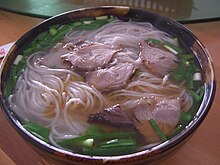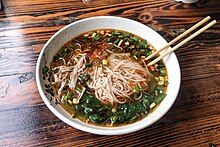Mixian (noodle)
This article relies largely or entirely on a single source. (June 2020) |
 | |
| Type | Chinese noodles |
|---|---|
| Place of origin | China |
| Region or state | Yunnan |
| Main ingredients | Non-glutinous rice |
| Variations | Ganjiang mixian, suanjiang mixian |

Mixian (simplified Chinese: 米线; traditional Chinese: 米線; pinyin: mǐxiàn) is a type of rice noodle from the Yunnan Province, China. These noodle are typically distinguished by their round shape, moderate thickness, and smooth, silky texture. They are normally used fresh and are commonly seen in stir-fry recipes, often served with rich broths and sauces.[1]
The Crossing-the-bridge noodles (pinyin:guò qiáo mǐ xiàn) are the most popular way to eat Mixian.
Production
[edit]The processing of mixian in Yunnan is unique, involving a fermentation process. In many areas there are at least two distinct thicknesses produced, a thinner form (roughly 1.5 mm or 0.059 inches in diameter) and a thicker form (roughly 3.5–4 mm or 0.14–0.16 inches in diameter).
Nutritional Value
[edit]High-quality Mixian provide essential nutrients such as minerals, carbohydrates, vitamins, and enzymes. They are easy to cook, evenly textured, and resistant to overcooking. When combined with various veggies, meats, and eggs, they become even more healthful and tasty. The combination with spicy broth enriches their flavor while remaining easy to digest, making them appropriate for quick meals or fast food consumption.
Rice noodles provide essential energy from starch, which helps with brain function, and their dietary fiber encourages healthy digestion. They also help to conserve body protein and have a warming effect on the stomach, which is beneficial for easing stomach cold symptoms. They are also helpful for spleen and stomach, helping with illnesses like indigestion. Although rice noodles lose some nutrients when soaked, mixing them with a variety of seasonings helps to preserve their nutritional value and flavor.[2]
Serving
[edit]Mixian is served in various ways, either in broth or stir-fried.
Stir-fried
[edit]Stir-fried preparation is rapid, most common in the evening, and is popular at roadside barbecue-type stands throughout Yunnan. Egg, tomato, meat, spring onion and chilli are frequently utilized.

Broth
[edit]
Condiments vary significantly but may typically include some subset of the following:
- chicken powder or essence
- chili pepper (diced fresh chili, plus at least one or two prepared chilli pastes, often mixed with oil)
- chrysanthemum flowers
- coriander
- mint
- garlic (often finely diced, in liquid suspension, or in thin sectioned slices)
- ginger (as above, but less commonly in slices)
- pepper (both regular pepper and powdered or whole Sichuan pepper)
- salt
- sesame oil
- Sichuan pepper oil
- soy sauce
- spring onion
- suan cai (pickled or preserved vegetable)
- tomato
- vinegar
- wood ear mushroom
- zhe'ergen (a spicy root common to southwestern China).
Varieties of Rice Noodle Dishes
[edit]Crossing-the-Bridge Rice Noodles
[edit]Crossing-the-Bridge Rice Noodles is a popular Yunnan, China delicacy with a lengthy history. Its preparation is unique: a rich broth prepared from chicken, pork bones, ham, and duck serves as the foundation. Raw rice noodles are then added to the boiling broth and cooked, followed with veggies and seasonings. The recipe is finished by adding an egg yolk and sesame oil to the soup and garnishing with chopped green onions and cilantro. This procedure maintains the freshness and flavor of the components.
Dry Mixed Rice Noodles
[edit]Dry Mixed Rice Noodles are a popular dish known for being served without broth. Instead, they're spiced with scallions, garlic, ginger, chili sauce, soy sauce, vinegar, and crushed peanuts. Additional toppings like as minced meat, tofu strips, and eggs improve the flavor of the noodles, making them flavorful, dry, and silky. This recipe is perfect for a quick breakfast or lunch.
Meat Bone Rice Noodles
[edit]Meat Bone Rice Noodles are a nutritious dish made with pork bones, tendons, and shredded pork as the key ingredients. The pork bones are cooked until soft, and the rich broth is absorbed by the rice noodles, keeping them savory and tasty. Ginger, garlic, and cilantro are frequently used for seasoning.
Sour and spicy rice noodles
[edit]Sour and spicy rice noodles are popular for their refreshing flavor. The noodles are combined with vinegar, chile oil, crushed peanuts, and other seasonings to get a sour and spicy balance. Thin slices of tofu, cucumber, and radish are typically added for extra texture and nutrients, making this dish an ideal choice for a light and refreshing dinner, especially in the summer[3].
Geographic extent
[edit]Mixian is popular in Yunnan Province, where it can be found in many streets and villages, and is occasionally available in other mainland Chinese cities. It is generally very difficult to obtain outside of mainland China, probably since the fresh method of preparation could be seen to necessitate a certain minimum volume of consumption in order to be commercially viable. It is relatively similar to noodles consumed in neighbouring Laos (feu) and Vietnam (phở), with the key difference that the base mixian broth is usually heavily personalized by the customer in Yunnanese tradition, and the establishment's own pre-made broth is less adulterated and more significantly appreciated/judged as a key factor in Vietnam (and perhaps to a lesser extent Laos). Dishes like nan gyi thohk and baik kut kyee kaik in various parts of Myanmar are based on a similar dimension of rice noodle but differ broadly in flavour profile (tending more toward flavours in Indian cuisine with ingredients such as chickpea flour) and preparatory method (far greater use of frying). It is more common in unadulterated Yunnanese form in commercial centers of Myanmar with growing Chinese populations, such as Mandalay. Dishes in Thailand such as pad thai also rely on rice noodles, though often they are flat and therefore more similar to Chinese juanfen or Yunnanese migan. A Tibetan broth-based noodle dish using wheat-flour instead of rice-flour noodles, thukpa, is thought to have originated in eastern Tibet (i.e. closer to Yunnan) and is made and enjoyed throughout Bhutan, Northeast India, Nepal, Sikkim and Tibet.
See also
[edit]- Migan (noodle)
- Rice, History of domestication and cultivation
- Yunnan cuisine
- Khanom chin, a Thai fermented-rice noodle
References
[edit]- ^ "Mixian | Local Rice Noodles From Yunnan". www.tasteatlas.com. Retrieved 2024-10-19.
- ^ "米线富含哪些营养功效?渝辣记火锅米线告诉你_食用". www.sohu.com. Retrieved 2024-10-19.
- ^ "米线:一份美味与文化的享受_云南_美食_食用". www.sohu.com. Retrieved 2024-10-19.
